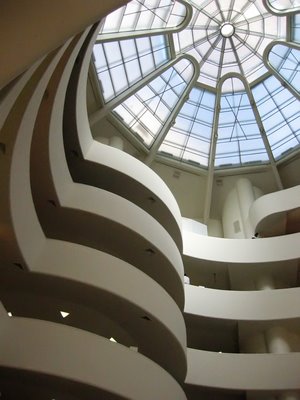I Just Read...
I just read two really interesting articles on a couple of my favorite blogs. The first is from BLDGBLOG and the second isn't a blog at all, but a newsletter that I found a link to about land use. I think what I found so interesting about the two articles was that they echoed ideas that Alex and I have talked about quiet often. When you realize that everything you do is built upon something else, it's really difficult to fathom. The second part that I liked about the article was the connection to the Guggenheim Mueseum in NYC. I don't know if Wright had intended the connection, but as soon as I read that the Guggenheim family had financed the big hole, and read about the corkscrew, I made the same connection. Intentional or not, it is interesting. Below are the quotes I was talking about and a couple of pictures:

The nails that hold the place together come from the Mesabi Range. His downspouts are covered with zinc that was probably taken out of the ground in Canada. The tungsten in his light bulbs may have been mined in Bishop, California. The chrome on his refrigerator door probably came from Rhodesia or Turkey. His television set almost certainly contains cobalt from the Congo. He uses aluminum from Jamaica, maybe Surinam; silver from Mexico or Peru; tin – it's still in tin cans – from Bolivia, Malaya, Nigeria. People seldom stop to think that all these things – planes in the air, cars on the road, Sierra Club cups – once, somewhere, were rock. Our whole economy – our way of doing things. Oh, gad! I haven't even mentioned minerals like manganese and sulphur. You won't make steel without them. You can't make paper without sulphur..."Rearranging planets into TVs. Producing objects from geology.(apparently, this quote is actually a quote of a quote from this book.)

The Bingham pit may or may not be “the biggest hole on earth” (a copper mine in Chile may have surpassed it), but it really doesn’t matter. It is 2.5 miles wide and 3/4 mile deep. Looking into it is like looking into space. It is the ultimate man made landscape void. When the pit first began operation, in 1907, it was the first large scale open pit operation in the US. Moving enough material to process this much low grade ore had never been done. The bold plan that was implemented used a railway with movable tracks to transport the tremendous amounts of rock out of the pit. The train spiraled into the mountain on tracks built on the ledges of the sides. The effect was like a giant screw drill. Funding for the project came from the Guggenheim family, who later built a museum bearing their name in New York City with the profits made from investments in industry across the country, like the Bingham Pit. The museum is a kind of cultural ingot extracted and refined from the raw material of the earth. And the museum, curiously, has a multi-story open space in the middle, surrounded by a long spiral ramp.



1 Comments:
Hey, wanna hear something I learned at the San Diego Zoo today? The increased mining of a mineral called coltan, used to make cell phones, is distroying gorilla habitat in South Africa, and pushing the species closer to extinction. It's also contributing to civil war, according to this website: http://www.seeingisbelieving.ca/cell/kinshasa/
Just, you know, thought I'd add something cheery.
Post a Comment
<< Home